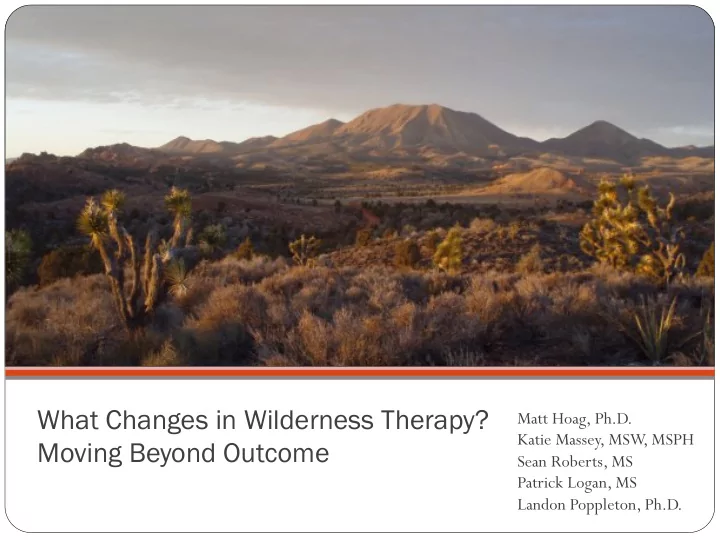

What Changes in Wilderness Therapy? Matt Hoag, Ph.D. Katie Massey, MSW , MSPH Moving Beyond Outcome Sean Roberts, MS Patrick Logan, MS Landon Poppleton, Ph.D.
What Changes in Wilderness Therapy? Moving Beyond Outcome Need for outcome research Research goals Methods Results Challenges and limitations Conclusion Discussion
Need for evaluative research in wilderness therapy Growth in the wilderness therapy industry Demand for mental health services and lack of them Estimated 10,000 clients each year in wilderness Expectation for evidence-based practices in mental health Fundamental need to evaluate programs and outcomes Accountability to clients and families, the GOA, insurance, and accrediting bodies Growing, but still limited data OBHRC major contributions over the last 10 years Other than OBHRC, few others have employed large sample sizes and sophisticated methodologies
Research Goals To evaluate the efficacy of Second Nature Entrada Efficacy – Behavioral changes over the course of the program To learn more about what may predict and improve treatment outcomes in wilderness therapy Factors examined : motivation for treatment, hope, …..
Methods Adolescent and adult clients enrolled from May 2008 through February 2011 Adolescent clients, parents of adolescents, and adult clients completed standardized and validated measures at: Week 1, Week 3, Week 5 Discharge 6 months post discharge
Pilot Measures Adolescent measures YOQ (Parent, teacher & Self-Report) Treatment Expectancy Questionnaire Therapeutic Alliance Scale Life Effectiveness Questionnaire Hope Scale Adult measures OQ-45.2 Motivation for Therapy Scale Helping Alliance Questionnaire-II Life Effectiveness Questionnaire Dysfunctional Attitudes Scale
Adolescent Study Flow Chart: Baseline • Parents: Y-OQ 2.01 Y-OQ -SR 2.0, TEQ , LEQ, HS, TAS • Students: Week 3 • Parents: Y-OQ 2.01 • Students: Y-OQ -SR 2.0, TEQ, LEQ, HS, TAS Week 5 • Parents: Y-OQ 2.01 • Students: Y-OQ -SR 2.0, TEQ, LEQ, HS, TAS Discharge • Parents: Y-OQ 2.01 • Students: Y-OQ -SR 2.0, TEQ, LEQ, HS, TAS 6 months post discharge • Parents: Y-OQ 2.01 • Students: Y-OQ -SR 2.0, TEQ, LEQ, HS, TAS
Adult Study Flow Chart Baseline • Clients: OQ, CMOTS, DAS, LEQ, HAQII Week 3 • Clients: OQ, CMOTS, DAS, LEQ, HAQII Week 5 • Clients: OQ, CMOTS, DAS, LEQ, HAQII Discharge • Clients: OQ, CMOTS, DAS, LEQ, HAQII 6 months post discharge • Clients: OQ, CMOTS, DAS, LEQ, HAQII
Sample Baseline Adolescents: 116 Adults: 294 Week 3 Adolescents: 100 Adults: 243 Week 5 Adolescents: 96 Adults: 215 Discharge Adolescents: 85 Adults: 156
Typical Client Profile 69% male, 31% female Average stay for all clients from May 2008 to January 2011: 9.3 weeks Presenting problems Depression, bipolar disorder, and anxiety Substance abuse and dependence ADHD, learning difficulties Low self esteem Attachment and adoption issues Family Conflict NLD, Aspergers Social problems
Outcome among adolescent clients Significant improvements from intake to discharge on: YOQ-SR YOQ 2.01 LEQ HS TEQ TAS and YOQ-Teacher were not significant
YOQ - Parent Assessment 120 100 Community functioning cutoff 80 score 60 40 20 0 Intake 3 Week 5 Week Discharge 6 Month
YOQ – Adolescent Self Report 100 90 80 Community functioning 70 cutoff score 60 50 40 30 20 10 0 Intake 3 Week 5 Week Discharge 6 Month
Life Effectiveness Questionnaire 170 165 160 155 150 145 140 135 Intake 3 Week 5 Week Discharge
Hope Scale 40 35 30 25 20 15 10 Intake 3 Week 5 Week Discharge
Treatment Expectancy Questionnaire 55 50 45 40 35 30 25 20 Intake 3 Week 5 Week Discharge
Adolescent paired t- tests Measure: Lower CI Upper t df Sig (2 tailed) Intake - Discharge CI YOQ - SR 30.17 43.41 11.07 75 .000 YOQ Parent 39.19 83.74 5.96 13 .000 TEQ -14.17 -7.90 -7.01 76 .000 TAS 4.06 -1.64 -4.70 61 .000 LEQ -26.53 -14.92 -7.11 74 .000 HS -7.95 -5.04 -8.88 75 .000
Outcome with Adults Significant improvements from intake to discharge: OQ 45.2 LEQ TEQ DAS HAQ-II did not show significance
Adult Client - Outcome Questionnaire 80 70 Community ¡ func,oning ¡ 60 cutoff ¡score ¡ ¡ 50 40 30 20 Intake 3 Week 5 Week Discharge 6 Month
Dysfunctional Attitudes Scale (Adult) 125 120 115 110 105 100 95 90 85 80 Intake 3 Week 5 Week Discharge
Life Effectiveness Questionnaire (Adult) 170 160 150 140 130 120 110 Intake 3 Week 5 Week Discharge
Motivation for Therapy (Adult) 70 65 60 55 50 45 40 Intake 3 Week 5 Week Discharge
Adult paired t-test Measure: Lower Upper t score df Significance Intake- CI CI (2 tailed) Discharge OQ 24.40 31.56 15.45 146 .000 CMOTS -6.00 -3.31 -6.84 144 .000 DAS 28.14 40.22 11.18 145 .000 HAQ -12.68 -7.80 -8.30 131 .000 LEQ -28.68 -19.96 -11.03 133 .000
Cha halle lleng nges a and nd li limi mitations ns: : Attrition a n and nd p parent nt p participation n
Attrition rate Adolescent Parents of Adult clients adolescents clients Intake to discharge 31% 60% 47% Intake to 6 months 91% 73% 97% follow up
Attrition in comparison Behrens, 2008 Post discharge follow up attrition: Parents 63% Students: 81% Russel, 2003 Intake to Discharge attrition: Parents = 53% Students = 21% 12 month post discharge Random sample of 99 students and parents Response rate: parents = 78%, students = 40%
Comparing Parent Y-OQ Scores for Adolescents 120 100 80 Russell 60 Open Sky 40 2NE 20 0 Intake Discharge
Comparing Y-OQ student self reports 80 70 60 50 Russell 40 Open Sky 30 2NE 20 10 0 Intake Discharge
Summary Significant improvements for adolescent and adult clients while in the program Clients also demonstrated more hope, life skills, optimism, problem solving abilities, and felt better about themselves Challenges following up with clients
Future directions Focus on attrition, follow up, and parent participation
Contact information Matt Hoag, Ph.D. matt@snwp.com Katie Massey, MSW , MSPH katiem@snwp.com Patrick Logan, MS patrick@snwp.com
Recommend
More recommend